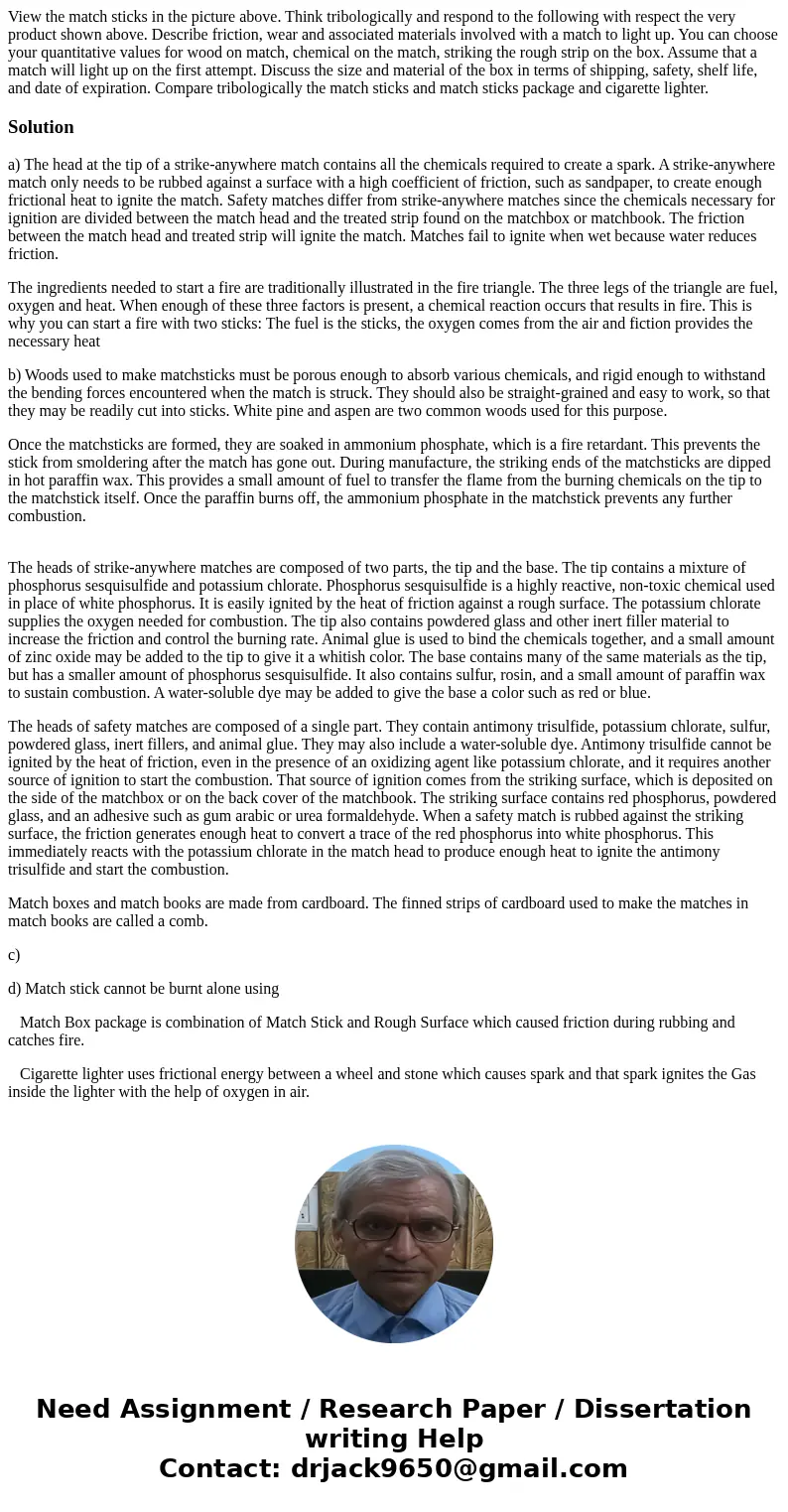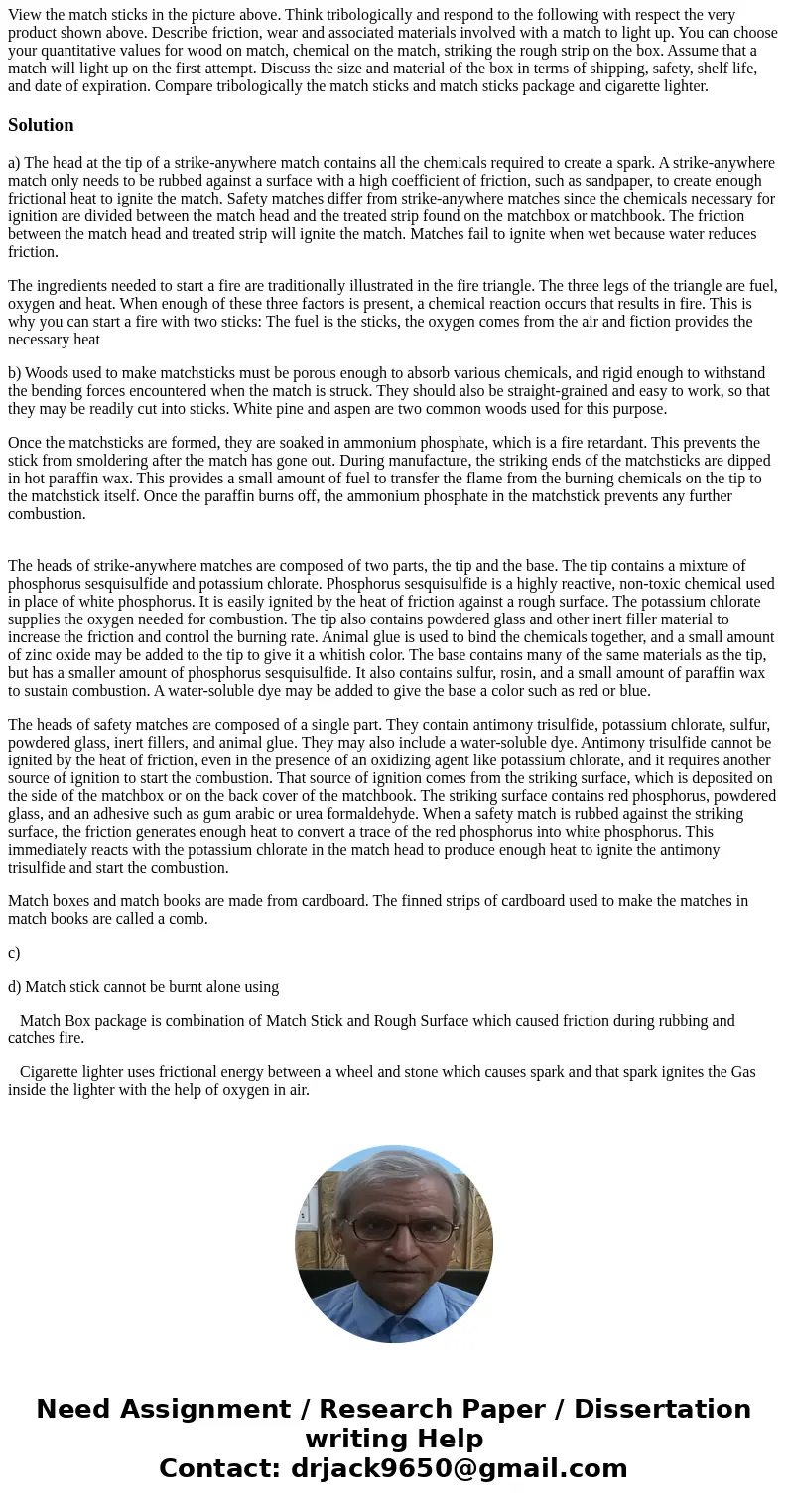View the match sticks in the picture above Think tribologica
Solution
a) The head at the tip of a strike-anywhere match contains all the chemicals required to create a spark. A strike-anywhere match only needs to be rubbed against a surface with a high coefficient of friction, such as sandpaper, to create enough frictional heat to ignite the match. Safety matches differ from strike-anywhere matches since the chemicals necessary for ignition are divided between the match head and the treated strip found on the matchbox or matchbook. The friction between the match head and treated strip will ignite the match. Matches fail to ignite when wet because water reduces friction.
The ingredients needed to start a fire are traditionally illustrated in the fire triangle. The three legs of the triangle are fuel, oxygen and heat. When enough of these three factors is present, a chemical reaction occurs that results in fire. This is why you can start a fire with two sticks: The fuel is the sticks, the oxygen comes from the air and fiction provides the necessary heat
b) Woods used to make matchsticks must be porous enough to absorb various chemicals, and rigid enough to withstand the bending forces encountered when the match is struck. They should also be straight-grained and easy to work, so that they may be readily cut into sticks. White pine and aspen are two common woods used for this purpose.
Once the matchsticks are formed, they are soaked in ammonium phosphate, which is a fire retardant. This prevents the stick from smoldering after the match has gone out. During manufacture, the striking ends of the matchsticks are dipped in hot paraffin wax. This provides a small amount of fuel to transfer the flame from the burning chemicals on the tip to the matchstick itself. Once the paraffin burns off, the ammonium phosphate in the matchstick prevents any further combustion.
The heads of strike-anywhere matches are composed of two parts, the tip and the base. The tip contains a mixture of phosphorus sesquisulfide and potassium chlorate. Phosphorus sesquisulfide is a highly reactive, non-toxic chemical used in place of white phosphorus. It is easily ignited by the heat of friction against a rough surface. The potassium chlorate supplies the oxygen needed for combustion. The tip also contains powdered glass and other inert filler material to increase the friction and control the burning rate. Animal glue is used to bind the chemicals together, and a small amount of zinc oxide may be added to the tip to give it a whitish color. The base contains many of the same materials as the tip, but has a smaller amount of phosphorus sesquisulfide. It also contains sulfur, rosin, and a small amount of paraffin wax to sustain combustion. A water-soluble dye may be added to give the base a color such as red or blue.
The heads of safety matches are composed of a single part. They contain antimony trisulfide, potassium chlorate, sulfur, powdered glass, inert fillers, and animal glue. They may also include a water-soluble dye. Antimony trisulfide cannot be ignited by the heat of friction, even in the presence of an oxidizing agent like potassium chlorate, and it requires another source of ignition to start the combustion. That source of ignition comes from the striking surface, which is deposited on the side of the matchbox or on the back cover of the matchbook. The striking surface contains red phosphorus, powdered glass, and an adhesive such as gum arabic or urea formaldehyde. When a safety match is rubbed against the striking surface, the friction generates enough heat to convert a trace of the red phosphorus into white phosphorus. This immediately reacts with the potassium chlorate in the match head to produce enough heat to ignite the antimony trisulfide and start the combustion.
Match boxes and match books are made from cardboard. The finned strips of cardboard used to make the matches in match books are called a comb.
c)
d) Match stick cannot be burnt alone using
Match Box package is combination of Match Stick and Rough Surface which caused friction during rubbing and catches fire.
Cigarette lighter uses frictional energy between a wheel and stone which causes spark and that spark ignites the Gas inside the lighter with the help of oxygen in air.


 Homework Sourse
Homework Sourse